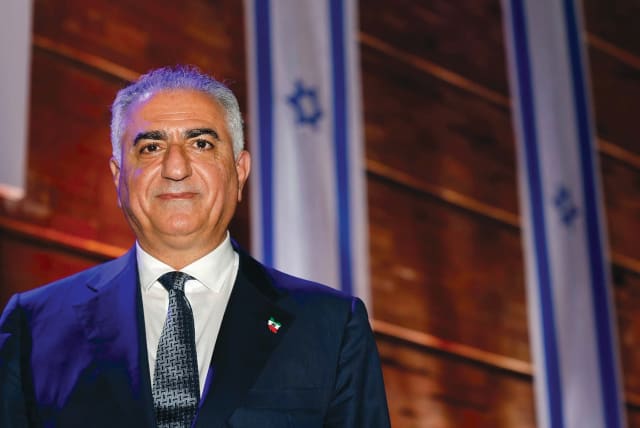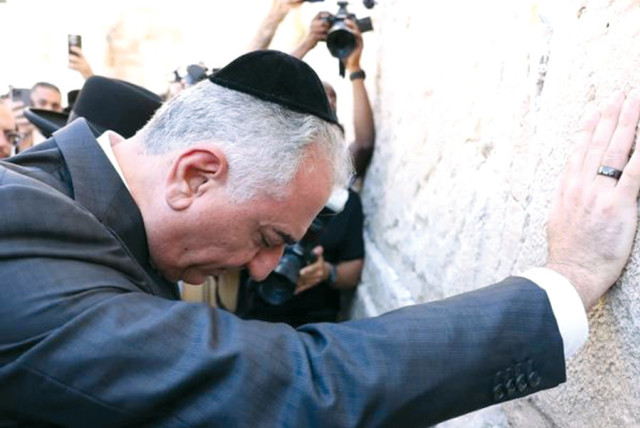The Cyrus of our time

The shah's son Reza Pahlavi visits Israel and leads a government-in-exile with the goal of brining democracy to Iran.
Reza Pahlavi, the man born to be shah of Iran and who, for the first 19 years of his life was the country’s crown prince, paid his first visit to Israel on April 17 of this year.
When his father, Mohammad Reza Pahlavi, the shah of Iran, faced by an army mutiny and violent public demonstrations, went into voluntary exile on January 17, 1979, young Pahlavi was a trainee fighter pilot at a US air base in Texas. Two weeks later, Ayatollah Ruhollah Khomeini, the spiritual leader of the Islamic revolution, took control of the country. Neither Pahlavi nor his father ever set foot in Iran again.
Ahead of his recent visit, Pahlavi said: “I am traveling to Israel to deliver a message of friendship from the Iranian people…I want the people of Israel to know that the Islamic Republic does not represent the Iranian people. The ancient bond between our people can be rekindled for the benefit of both nations. I’m going to Israel to play my role in building toward that brighter future.”
His supporters like to brand Pahlavi “the Cyrus of our time,” comparing him to Cyrus the Great, a revered ruler who founded the Persian empire millennia ago. Pahlavi used the comparison, but with a Jewish twist, when tweeting a picture of himself at the Western Wall on April 18 wearing a kippa. He reminded his followers that 2,500 years ago Cyrus the Great liberated the Jewish people from their exile in Babylon and helped them build the Second Temple in Jerusalem.
“It is with profound awe that I visit the Western Wall of that Temple,” said Pahlavi, “and pray for the day when the good people of Iran and Israel can renew our historic friendship.”

He quoted a verse from the Bible: “So said Cyrus, the king of Persia, ‘All the kingdoms of the earth the Lord God of the heavens delivered to me, and He commanded me to build Him a House in Jerusalem, which is in Judea.’”
As part of his historic visit, Pahlavi attended a Holocaust Remembrance Day ceremony at Yad Vashem, standing alongside Prime Minister Benjamin Netanyahu and President Isaac Herzog.
Reza Pahlavi's Iranian government-in-exile
To end his own exile has been Pahlavi’s main purpose in life for the past 44 years. Though living in the West under the constant threat of assassination, he has campaigned constantly for the overthrow of the rule of the ayatollahs and to return home to Iran to create a new modern, liberal democracy that respects human rights, freedom and equality.
In pursuit of his aim, he leads a body called the National Council of Iran for Free Elections (NCI). The council, an umbrella group of exiled opposition figures, seeks to restore Pahlavi to the leadership of Iran either as shah or as president. Meanwhile, it acts as a government-in-exile and claims to have gathered “tens of thousands of pro-democracy proponents from both inside and outside Iran.”
As an underground movement, operating through social media and word of mouth, Pahlavi says it has drawn support from within the regime. “We have former diplomats, media people, branches of the military, including the Revolutionary Guard.”
He believes the ayatollahs are pressing down the lid of a simmering cauldron of dissatisfaction among a large proportion of the Iranian people, a cauldron that will one day boil over and sweep them away. It is certainly true that the Islamic revolution has never been completely clear of internal opposition, which has often erupted into open violence. For example, widespread demonstrations followed the 2009 presidential election, which it was generally believed was subject to vote rigging and election fraud.
By January 2018, ever-rising food and commodity prices and a deteriorating economic situation again led to popular protests which threw Iran into turmoil. These economic grievances soon morphed into opposition to the regime in general and the Supreme Leader, Ayatollah Ali Khamenei, in particular. Dissent was voiced especially against the regime’s involvement in foreign enterprises, including direct engagement in the Syrian civil conflict, and costly military and logistical support for Hezbollah in Syria, for the Houthis in Yemen, and for Hamas in Gaza. The vast sums expended in these operations were seen as being at the direct expense of the Iranian population.
These mass anti-government demonstrations rumbled on into the early months of 2020. Among the slogans chanted by protesters across the country and reported in the media were “Bring back the Shah” and “Reza Shah, rest in peace”.
Then on September 13, 2022, Mahsa Amini, a 22-year-old Iranian woman, was arrested by Iran’s infamous morality police. Her nominal offense was that she was wearing her hijab “improperly.” Amini was taken to the Vozara Detention Centre. Three days later, she died.
Inspired by their young women, the Iranian nation erupted in protest. Thousands took to the streets in cities across the country. Very soon, the demonstrations had spread to all 31 of the country’s provinces. At first they were directed against the severe dress code imposed on women and enforced by the morality police. But soon the protesters began targeting the regime itself and the Supreme Leader. Posters with the slogan “Death to the Dictator” began appearing, and videos posted online showed demonstrators burning images of Khamenei and calling for the return of the Pahlavi dynasty.
A major problem for Reza Pahlavi and his government-in-exile is that he is not the only contender for power in a democratic post-ayatollah Iran. Seeking the same outcome and declaring itself a parliament-in-exile is an organization calling itself by the worryingly similar title of The National Council of Resistance of Iran (NCRI).
Founded in 1981, the NCRI seeks to establish a pluralistic, multi-party and democratic system in Iran. It declares that after the overthrow of the ayatollahs’ regime, it would run the country for no more than six months, during which its primary task would be to set up free and fair elections for a national assembly. Its president-elect is a remarkable woman, Maryam Rajavi, who is utterly opposed to fundamentalist interpretations of Islam.
One main difference between the two councils is that the NCRI does not embrace the possibility of a return to the monarchy. It was founded on the basis of “No to the Shah and no to the Mullahs.” In fact, it states that “the model of monarchy, which is also a model of dependence and despotism, has failed.” The idea of a constitutional monarchy, because it is alien in the Middle East, does not enter their thinking, and it aims to establish a republic in post-ayatollah Iran. Pahlavi, however, says that would be fine with him. He stands ready to serve his country regardless, as sovereign or as president.
“Everybody knows that I carry the monarchic heritage,” he says, but “if the country is more ready for a republic, even better. That’s great.”
At the moment, Pahlavi’s emollient words seem unlikely to influence the uncompromising political objectives underlying the NCRI. Rajavi may see herself as the eventual president of a liberalized Iran and would find no role for Pahlavi. If that is how the NCRI thinks, it is a dangerously blinkered view. Politically, personally and nostalgically, Pahlavi has a large following within Iran, and his presence leading an anti-regime movement, or at least in a leadership role, would carry great weight. The NCRI ignores this political reality at its peril.
At the moment, the two councils are far apart. Yet clearly, their fundamental aims overlap to a considerable extent. It seems obvious that to achieve success in their common purpose, the two councils must come together and thrash out an agreed policy. Ideally, they should open negotiations as soon as possible with the aim of amalgamating. ■
Follow the writer at: www.a-mid-east-journal.blogspot.com
